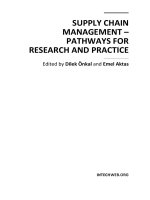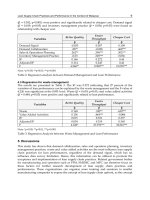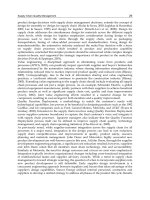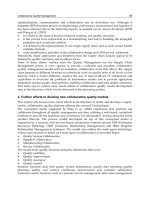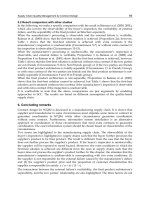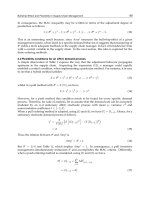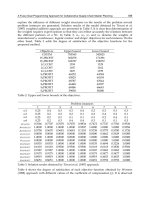Integrating Handheld Computer Technology into HR Research and Practice
Bạn đang xem bản rút gọn của tài liệu. Xem và tải ngay bản đầy đủ của tài liệu tại đây (963.62 KB, 37 trang )
Integrating Handheld Computer Technology 31
Copyright © 2005, Idea Group Inc. Copying or distributing in print or electronic forms without written
permission of Idea Group Inc. is prohibited.
Chapter II
Integrating Handheld
Computer Technology
into HR Research
and Practice
Scott A. Davies, Hogan Assessment Systems, USA
Robert F. Calderón, Caliber Associates, Inc., USA
Abstract
Current theory, applications, and future opportunities for the utilization
of handheld computer technology in HR research and practice are presented
in this chapter. Empirical research findings on the use of handheld
computers for passive collection of workplace data and as a platform for
electronic diaries are presented. Potential applications of handheld
computers for HR practice are also presented. Finally, current issues and
opportunities concerning integration of handheld computer technology
into HR research and practice are discussed.
32 Davies & Calderón
Copyright © 2005, Idea Group Inc. Copying or distributing in print or electronic forms without written
permission of Idea Group Inc. is prohibited.
Introduction
The integration of handheld computer technology with human resource (HR)
research and application is an area that has not received a great deal of attention
from HR researchers or practitioners. However, as the efficiencies and
economies associated with handheld computers have continued to increase
over the past five years, with meaningful advancements in hardware (e.g., 400
MHz processor speeds, transflective color screens), storage (e.g., 1GB+
memory cards), software (e.g., MS Pocket PC 2003), and wireless connec-
tivity options (e.g., Bluetooth, Wi-Fi, Sprint PCS 153 Kbps service), their
utility to human resource research and practice is greater than ever. Based on
our research, we believe that full utilization of handheld computers in HR will
be most fully realized through the collaborative efforts of HR researchers,
practitioners, and IT specialists.
In this chapter we bring together empirical research and practical knowledge
on the integration of handheld computer technology with strategic human
resource planning, management, and research theory into a working model that
may serve as a foundation for future work in this area. We begin with an
overview of how handheld computer technology fits into a model with HR
research, HR practice, and IT infrastructure. We then review the role of
handheld computers in strategic human resource practice and research, includ-
ing the use of handheld computers to: (a) gather data for business process
engineering, workflow mapping, and job analysis; (b) conduct organizational
needs assessments; (c) gather and manage performance data, and provide
employee feedback in performance management systems; (d) provide training
to employees and gather training evaluation data; (e) conduct organizational
surveying; and (f) enhance administrative tasks, such as scheduling, messaging,
and provision of HR forms. Finally, we present our view of future research
opportunities and challenges associated with the integration of handheld
computer technology into strategic human resource planning, management, and
research.
We hope readers find what we present in this chapter useful to their own HR
research and practice. As in all applications of technology, the field is bursting
with activity and constantly changing, but we believe that the material presented
here will remain a relevant foundation for work in this area for the foreseeable
future. It is our goal not only to inform the reader, but to increase interest in
pursuing additional research in this area.
Integrating Handheld Computer Technology 33
Copyright © 2005, Idea Group Inc. Copying or distributing in print or electronic forms without written
permission of Idea Group Inc. is prohibited.
A Model of Handheld Computer
Technology Integrated into HR
Currently, handheld computers are often used as stand-alone devices in the
workplace to supplement individuals’ computing resources. This situation
neglects the potential for use of the technology in a systematic manner. In our
conceptual model (Figure 1), the boxes represent what we see are the three key
elements in the relationship between handheld computer technology and HR.
As shown by the arrows, this is not a linear relationship, but one of conver-
Figure 1. Working model of handheld computer technology integrated
into HR practice, research, and IT infrastructure
2. Research on handheld
computers in HR
Opportunity for
portable data
gathering with real-
time researcher and/o
r
employee input
Multimedia
capabilities
Diary capability
Capacity to both
“push” and “pull”
data from a network
1. Integration into
IT infrastructure
Handheld units
need to be linke
d
to IT network
through wireless
or terminals
IT training and
support needs fo
r
users
Opportunity for
strategic link
between HR and
IT
3. Application of
handheld computer
s
in strategic HR
planning and
management
Workflow
mapping
Needs
assessment
Performance
management
Training
provision
Organizational
surveying
Administrative
HR tasks
34 Davies & Calderón
Copyright © 2005, Idea Group Inc. Copying or distributing in print or electronic forms without written
permission of Idea Group Inc. is prohibited.
gence, with each element both contributing to and drawing from the other
elements. The key to optimizing the use of the handheld in HR research and
practice is attendance to all three factors in the model simultaneously.
Factor #1: Integration into IT Infrastructure
As with any organizational technology solution, handheld computers need to be
a part of the larger IT system. According to our model, IT integration is linked
to both the HR research and HR application factors. Some aspects of these
linkages are supported by empirical work in this area. For example, we have
found that optimal use of handheld technology in HR research requires
integration into the organization’s IT system as an enterprise solution (Davies,
Rodbard, Brandes, & Poropatich, 2004; Lyons, Davies, Rodbard, Brandes,
& Poropatich, 2004; Rodbard, Brandes, Davies, & Lyons, 2002). Further-
more, our research has shown that a lack of integration will be an insurmount-
able roadblock to successful handheld use. We have also found that successful
integration of handhelds as research or applied HR tools is dependent on
strategic links to the organizational IT infrastructure through HotSynching
terminals or wireless methods. Successful applications also require adequate,
ongoing IT-related training and support to handheld users. Finally, collabora-
tion between HR and IT staff is a critical factor in making integration of handheld
technology a part of an organization’s strategic business plan.
Factor #2: Research on Handheld Computers in HR
While integration into the IT system will make handheld technology available to
HR, it is up to the HR researchers to identify opportunities for a wide variety
of data-collection activities in the workplace, such as diary studies, multimedia
interventions, survey work, and real-time assessments/evaluations. Organiza-
tional researchers have begun to utilize handhelds in their research to a limited
extent, but the full potential of having entire organizations of respondents
voluntarily carrying computers around with them every day has not yet been
capitalized on for research purposes. We have identified four research func-
tions in our model that would be accentuated through handheld use, but the
published work in this area is scarce. As a notable exception, Miner, Glomb,
and Hulin (2001) gathered employee mood data in an experience sampling
Integrating Handheld Computer Technology 35
Copyright © 2005, Idea Group Inc. Copying or distributing in print or electronic forms without written
permission of Idea Group Inc. is prohibited.
design using the diary feature of handheld computers. From feedback we
received from others in the field, other programs of HR research using
handhelds exist, but are being conducted by organizations internally; as is too
often the case in applied settings, the results are not available for publication.
In our research, we utilized the real-time evaluation and diary function of the
handheld, but have not had the opportunity to explore multimedia and wireless
capabilities (Lyons et al., 2004; Rodbard et al., 2002). These conceptual
factors in our model provide an impetus for future empirical research.
Factor #3: Application of Handheld Computers in
Strategic HR Planning and Management
In our research, we have found that introducing handheld technology as a
platform for HR applications provides a means of conducting HR-related
research on a variety of issues (Lyons et al., 2004; Rodbard et al., 2002). This
is the basis for the relationship in our model between Factor #1, HR Research,
and Factor #2, HR Application. Our findings support the concept that the
research capacity of handhelds can be captured as a byproduct of the
implementation of HR functions on the same device. For example, in occupa-
tions that rely heavily on forms to complete work activities (e.g., nurses use
forms to chart patients, lawyers use forms to bill time, teachers use forms to
track students, warehouse workers use forms to maintain inventory), by placing
the forms on handhelds and passively gathering form use data from the devices,
research on workflow mapping, job analysis, and job design can be conducted
with little to no extra data collection. We expand on these findings in the
following sections on handheld applications and research.
Overall, we propose that the research and application of handheld technology
to HR functions would be well served to follow a conceptual model, not occur
in an unsystematic manner with post hoc evaluation, as is often the case.
Evidence that this may already be the state of the science in this area is the lack
of published research on handheld technology and HR (Cascio, 2003). There
is much to be gained in this potentially fruitful area of HR practice and research
by working from a common understanding and publishing results both support-
ive and unsupportive of that understanding.
In our model, we acknowledge the importance of relating IT infrastructure to
HR practice and research on handhelds, but we do not further develop the IT
issue in this chapter. We urge the reader to examine resources and to
36 Davies & Calderón
Copyright © 2005, Idea Group Inc. Copying or distributing in print or electronic forms without written
permission of Idea Group Inc. is prohibited.
collaborate with IT experts in this area. In the following sections, we expand
on the research supporting Factors #2 and #3 of our model (Figure 1).
HR Applications on Handhelds
HR-related applications on handhelds are being developed at an ever-increas-
ing pace. The most popular of these falls into the realm of personal information
management (PIM) functions, such as a calendar, contact list, to-do list, and e-
mail. In our model, these functions on individual employee’s handhelds become
important parts of a strategic HR practice and, if managed properly, become
a system of organizational information management (OIM) functions.
Applications are available for time management, for example, that have
advanced capabilities for applying complex work rules (e.g., managing over-
time accruals and employee leave periods), processing time billing, providing
sophisticated scheduling, and allocation capabilities; they further include the
ability to equalize overtime in schedules, match skills to jobs, and provide a
platform for resource substitution and alternatives. Physicians in some medical
facilities are using a handheld device to manage a variety of workflow functions,
including accessing real-time patient scheduling information, capturing charges,
and dictating point-of-care patient notes. These professionals use their handheld
devices to review medical reference libraries, current diagnostic and procedure
coding, and coding compliance rules. These applications are applicable to
other occupations as well.
Organizational-level contact management can be accomplished by enabling
multiple handheld users to synchronize with a master list of contacts, update the
contact list, then resynchronize the changes to the master database. For
example, using a .NET Compact Framework solution on Pocket PCs provides
a SQL Server CE database on each device that contains a replica of the master
database. The handheld database is synchronized with the master database
programmatically to build the organizational contact list.
Most directly related to HR practice are applications that make various
organizational forms and documents available to employees on the handheld —
either downloadable from a PC or via distance connection through land-based
or wireless connection. Forms may be “pushed” out to employees as required,
or “pulled” as needed, completed, and returned electronically. Other applica-
Integrating Handheld Computer Technology 37
Copyright © 2005, Idea Group Inc. Copying or distributing in print or electronic forms without written
permission of Idea Group Inc. is prohibited.
tions enhance record keeping for traveling employees, including programs for
time management, project management, sales tracking, and expense accounts.
Handhelds are also capable of holding quick reference material that can be
accessed immediately in a non-cumbersome fashion. In some organizations,
individuals are able to reference journals/databases with the push of a button
and provide critical information in real time. For example, Hayes (2003)
examined the benefits of using handheld computers for a population of
psychiatrists and found that these devices were extremely useful in storing and
retrieving information and applications that could be accessed anyplace at
anytime. Basically, the handheld computers can provide the same basic benefits
that are available via an individual’s personal computer (e.g., reference
materials, Web searches), with the added bonus of being with the individual at
all times.
There are also many handheld applications with implications for potential HR
use. For example, organizations with workers in the field are finding rugged-use
handhelds useful for land surveying, mapping, civil engineering and construc-
tion, forestry, utility, facilities and asset management, machine control, law
enforcement, and military applications. The technology is also being used to
assist employment of people with disabilities. For example, networked job
training and coaching applications can be provided on handhelds with audio-
or graphics-based step-by-step instruction on how to complete a job, check
progress to completion, and as a means for family and coach to communicate
with workers (MobileVillage, 2003).
In summary, handheld technology is being utilized as a means to provide a wide
range of HR-related applications. In many cases, the opportunity exists for
provision of the HR function to be improved through the use of the handheld.
In our model, we conceptualize the relationship of HR functions on the handheld
to the IT infrastructure and increasing capacity for HR research. In the next
section, we describe how HR research and handheld research can be accom-
plished as a byproduct of handheld use.
Researching HR Functions
on Handhelds
In preparing this chapter, we discovered that the dearth of published research
on integration of HR functions and handheld technology continues. When we
38 Davies & Calderón
Copyright © 2005, Idea Group Inc. Copying or distributing in print or electronic forms without written
permission of Idea Group Inc. is prohibited.
first started work in this area in 2001, the lack of existing research was not
entirely surprising given the age of the technology. However, now — three
years later — the technology has matured and the body of research appears to
have grown very little. Much of the work that has been accomplished in this
area appears to be proprietary and therefore not available for our review. In this
section we present reviews of the few published studies we have identified,
along with a description of our own research program in this area.
A group of researchers at Carnegie-Mellon have conducted handheld research
since 1997 in the PEBBLES project (PDAs for Entry of Both Bytes and
Locations from External Sources). Although not explicitly focused on HR
functions, the work of the team is of importance to this area. For example, the
PEBBLES team has researched multi-machine user interfaces (MMUIs),
which are of importance in our conceptualization of handheld integration with
the larger IT system. In their research, the PEBBLES team has examined how
handhelds and PCs can be used together (Myers, 2001; Myers, Steil, &
Gargiulo, 1998).
In one study, the team found that in a meeting setting, handhelds could be used
to make a PC-based slide presentation more effective by providing additional
details of the presentation to handheld meeting attendees wirelessly, on
demand. The details included additional data, graphs, and other information
that were not included on the more macro slide presentation, but were of
interest to some of the attendees during the slide show (Myers, Steil, &
Gargiulo, 1998).
In another study, the team found that real-time classroom assessment via
handhelds linked wirelessly to the instructor’s PC was more effective from both
the student and instructor perspectives. Finally, the PEBBLES team is exam-
ining the effectiveness of handheld use by multiple meeting participants when
annotating large, shared electronic displays, such as military maps (Myers,
2001).
The bulk of the research on the use of handheld computers in organizational
settings has been conducted in medical facilities. Many resources have been
devoted to developing medical programs for handhelds, and evaluating both
their use and effectiveness in the work of medical professionals. For example,
Rosenbloom (2003) reported on the use of handhelds to reduce medical errors
in a number of ways across the medical professions. Primarily, Rosenbloom
identifies the need for medical providers to have the correct information in a
usable format at the point of care and recognizes the handheld as the best
portable platform for fulfilling this need.
Integrating Handheld Computer Technology 39
Copyright © 2005, Idea Group Inc. Copying or distributing in print or electronic forms without written
permission of Idea Group Inc. is prohibited.
Lanway and Graham (2003) reported a study on handheld implementation in
a medical facility, with results that generalize beyond the medical field. The
study involved nurses who performed primarily administrative functions in
evaluating quality of patient care. This role required a great deal of documen-
tation, usually at the site of patient service. The nurses were using a paper-
based system to meet the portability requirements and then transcribing the
handwritten notes onto their desktop computers as the opportunity arose. This
situation resulted in an unmanageable amount of lag time between evaluation
and feedback to the medical providers, and unnecessary costs for double
documentation. Finding that laptop computers were too bulky for the job, the
organization moved the nurses to wireless handheld computers. The nurses
could document the evaluations once and transmit the information immediately
to the organization’s mainframe for use. The use of handhelds saved the nurses
two to three hours each — per day — in the double documentation process.
Also, the immediate delivery of information back to the medical facility often
results in patient discharge a day earlier than under the old system — an
outcome that has shown in the decreasing average length of stay since the
handhelds were put into use. Finally, the researchers report that the nurses’ job
satisfaction has increased since the handheld technology has been imple-
mented. It is unlikely that these results would be specific to the medical field;
they would more likely generalize to administrative applications in other
professions.
The impact of handheld use in the medical profession has been noticed not only
by medical professions, but by corporations paying for healthcare as well. In
order to reduce healthcare costs due to prescription inaccuracies, insurance
billing errors, and other problems created by poor penmanship, General
Motors Corporation has distributed handhelds to over 5,000 physicians who
attend to the company’s employees (Konrad, 2001). Generalizing this technol-
ogy effort to the corporate HR program would probably have similar effects.
In our own research program (e.g., Rodbard et al., 2002), we are exploring the
use of handheld computers in both laboratory and field settings. Current
laboratory research is focusing on the human factors of the user-machine
interface and how those factors are impacted by various software solutions.
This basic research is primarily of importance to the IT domain for effective
hardware and software design; therefore, we do not describe that line of
research in this chapter. We will instead focus on the research we have
conducted on handheld computers in the field and present findings primarily of
importance to HR researchers and practitioners.
40 Davies & Calderón
Copyright © 2005, Idea Group Inc. Copying or distributing in print or electronic forms without written
permission of Idea Group Inc. is prohibited.
Description of the Rodbard Study
The goal of the Rodbard et al. (2002) study was to provide medical profession-
als with handheld computers, train the professionals to use the handhelds in their
work, and then gather data regarding when, how, and why the handhelds were
used. This study was unique in its inductive, “bottom-up” approach to under-
standing how professionals would use handhelds in their work, how work-
related functions could be provided on the handhelds, and how handhelds
would perform as data-gathering devices for organizational research.
Overall, the study employed both qualitative and quantitative methods, with
measurement of actual use from objective data captured from the handheld
computers, measurement of user preparation through survey methodology,
measurement of real-time user reactions through the use of an electronic diary
on the handhelds, and qualitative user input through focus groups and Delphi
methods. Use of multiple methods provided more valid measurement of the
complex phenomenon of interest in the workplace.
Participants
A total of 84 medical personnel from two military medical facilities participated
in our study of handhelds in the workplace. Specifically, the sample distribution
by occupation was as follows: 30 physicians, 26 nurses, 15 pharmacists, and
13 combat medics. The overall gender distribution was fairly even: 45 males
and 39 females. Ethnic origin was representative of the U.S. military population
and the area labor force.
Procedure
The concept of the study was to provide training and experience with handhelds
that were equipped with a variety of applications (i.e., 10 medical applications
and 14 personal information management applications) to incumbents in the
two medical facilities, and subsequently gather: (a) objective data on applica-
tion usage, (b) feedback through a diary style logbook on the handheld, (c)
qualitative information through focus groups, and (d) priorities regarding the
information gathered from this group of “experienced” users in a final Delphi-
oriented focus group session. In addition to these primary data, secondary
Integrating Handheld Computer Technology 41
Copyright © 2005, Idea Group Inc. Copying or distributing in print or electronic forms without written
permission of Idea Group Inc. is prohibited.
analyses were conducted to examine the utility of monitoring handheld use in the
workplace as a potential source of workflow mapping and rudimentary job
analysis data.
Readiness to Participate
In order to assess readiness to participate in the study and to plan training, we
administered a 20-item survey during the initial session with the participants,
measuring past experience with handhelds, computers in general, and software
use. Figure 2 shows the distribution of survey scores. It is important to note the
wide range of scores, indicating that participants came into this study with
relevant experiences ranging from none (i.e., “1”) to high expertise (i.e., “19”).
This is important to note in light of the findings in this study that regardless of
previous relevant experience, the majority of participants were willing and
eager to use the handheld computers with adequate training and support.
Training
Participants were provided training in three two-hour sessions, one week
apart. Training was conducted by an expert in medical informatics with several
years of experience with handheld computers, who was assisted by two PhD
psychologists. The design of the sessions was interactive, with hands-on
experiential learning as the primary focus. After each of the sessions, the
participants completed questionnaires to assess increases in relevant knowl-
edge and attitudes towards the handheld devices. Additionally, a 15-minute
‘mini’ focus group was conducted after each session in order to elicit the major
strengths and weaknesses of using the handheld computers in the work
environment.
The training sessions were a critical factor in the success of this study. From the
results of the knowledge questionnaires, focus group findings, and the obser-
vations of the training teams, the trainings effectively prepared even the least
experienced participant to use the handheld computer in his/her work. In most
cases, attitudes toward the devices (as elicited in the focus groups) moved from
negative to positive and fear to trust. Any initial resistance to the use of
handhelds by this group of medical professionals was found to diminish across
the span of the three training sessions. From our observations, this change was
42 Davies & Calderón
Copyright © 2005, Idea Group Inc. Copying or distributing in print or electronic forms without written
permission of Idea Group Inc. is prohibited.
due to an increased understanding of the benefits of the handheld computers to
the work through personal experiences and anecdotal learning from fellow
professionals (i.e., “I was able to access a necessary medical reference book
on my PDA during a critical diagnosis at bedside and this made me more
confident in my decision”).
Focus Groups
The mini focus group results provided focus for subsequent trainings and
support follow-up with individual participants, as well as a basis for the Delphi
portion of the study. The primary findings from these early group sessions
included:
• Caregivers are enthusiastic about using the handheld computers.
• Caregivers readily adopt both personal information management (PIM)
and selected medical applications into their daily practices.
• The handheld computers were easily configured and deployed to the
physicians, nurses, medics, and pharmacists.
• Skills sufficient to use the handhelds are easily acquired with limited
training and “buddy” support.
Figure 2. Histogram of previous relevant experience survey scores by
percent of participants at each score point, 1-20
Integrating Handheld Computer Technology 43
Copyright © 2005, Idea Group Inc. Copying or distributing in print or electronic forms without written
permission of Idea Group Inc. is prohibited.
• Caregivers request additional functionalities for the handhelds: access to
patient records, lab data, x-rays, patient instructional materials, CME
credits, and the Internet.
Support
Participants also received ongoing support in their use of the handheld
computers through a buddy system. We actively promoted less well-prepared
participants to team with better prepared participants within their work
environment. This was also a critical success factor in conducting the study and
for implementing the technology. Through this system, individuals were able to
access support specific to the problem encountered, both at the point in time
most needed and from a recognized coworker. Participants were also provided
support from the research team via e-mail, telephone contact, site visits, and
from the base IT staff on an ongoing basis.
Research Methods
Throughout the course of the study (i.e., eight weeks), we utilized application
use tracking software on the handheld computers to track the use of various
handheld applications. We employed “App Usage Hack, Version 1.1” from
Benc Software for this purpose (Benc, 2002). In addition, we requested the
developer of App Usage Hack to create a version that would also record the
date, time, and duration of each use of each application. The latter version,
designated App Usage Hack Version 1.2, was employed for our studies. In this
manner, we were able to examine patterns of use by participant, day, time of
day, and day of week.
Use of this advanced version resulted in a decreased need for frequent
HotSyncing (i.e., linking the handheld computer to a desktop computer through
a cradle to synchronize the data on shared programs) on the part of partici-
pants. Even if the participant HotSynced only once — at the end of the study
— we could still identify the pattern of use, day-by-day and week-by-week
(provided that data were not lost or corrupted due to battery failure or
inappropriate use of Backup and Restore functions).
Our analysis of the use-tracking data resulted in profiles of application usage
at the person and group level, and provided a basis for describing differences
44 Davies & Calderón
Copyright © 2005, Idea Group Inc. Copying or distributing in print or electronic forms without written
permission of Idea Group Inc. is prohibited.
in handheld application usage across medical professions. In order to better
understand the usage data, we employed focus groups and logbook software
on the handheld devices for gathering reaction data from participants.
The logbook, a form of electronic diary, was designed as a standardized survey
form. It was well received by participants and would be useful for gathering a
variety of input from employees. The participants were instructed to access the
logbook at least once a day, and each time they had a critical experience with
the handheld computer. Also, the participants received automatic alarms on
their handheld every week reminding them to HotSync, as well as reminders
every second day to make a recording in their logbooks. The logbook asked
five questions with a five-point response scale for each:
1. If a specific application was the subject of the report, which application
was it?
2. How many times was the application used today, or if not a specific
application, how many times the handheld was used?
3. Did the application or handheld save time, and if so, how much?
4. Did the application or handheld make your job easier?
5. Comments.
The participants had the option to change answers, which were then stored in
a HanDBase file for downloading at HotSynch and collection by the research
team.
Focus groups were conducted at the end of each training session and followed
appropriate protocol for qualitative data gathering (Berg, 2001). The partici-
pant discussion was guided by two or three primary points provided at the
beginning of the focus group by a trained facilitator. Participants were given the
opportunity to speak to the points, with the goal of eliciting the most information
possible from the group. The groups were recorded in both audio and video
format for content analysis. The audio recordings were transcribed and content
analyzed using the Qualrus (2002) software program.
A special type of focus group was conducted at the end of the eight-week
study. Ten to 15 participants were assigned to each of five Delphi focus groups.
The Delphi method uses a conventional facilitated focus group format, but adds
structured lists of issues within a topic of interest. Each member of the group
independently reads and rates the importance of the issues on the list, and then



